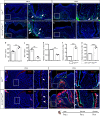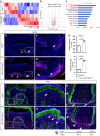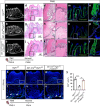FGF signaling modulates mechanotransduction/WNT signaling in progenitors during tooth root development
- PMID: 38910207
- PMCID: PMC11194271
- DOI: 10.1038/s41413-024-00345-5
FGF signaling modulates mechanotransduction/WNT signaling in progenitors during tooth root development
Abstract
Stem/progenitor cells differentiate into different cell lineages during organ development and morphogenesis. Signaling pathway networks and mechanotransduction are important factors to guide the lineage commitment of stem/progenitor cells during craniofacial tissue morphogenesis. Here, we used tooth root development as a model to explore the roles of FGF signaling and mechanotransduction as well as their interaction in regulating the progenitor cell fate decision. We show that Fgfr1 is expressed in the mesenchymal progenitor cells and their progeny during tooth root development. Loss of Fgfr1 in Gli1+ progenitors leads to hyperproliferation and differentiation, which causes narrowed periodontal ligament (PDL) space with abnormal cementum/bone formation leading to ankylosis. We further show that aberrant activation of WNT signaling and mechanosensitive channel Piezo2 occurs after loss of FGF signaling in Gli1-CreER;Fgfr1fl/fl mice. Overexpression of Piezo2 leads to increased osteoblastic differentiation and decreased Piezo2 leads to downregulation of WNT signaling. Mechanistically, an FGF/PIEZO2/WNT signaling cascade plays a crucial role in modulating the fate of progenitors during root morphogenesis. Downregulation of WNT signaling rescues tooth ankylosis in Fgfr1 mutant mice. Collectively, our findings uncover the mechanism by which FGF signaling regulates the fate decisions of stem/progenitor cells, and the interactions among signaling pathways and mechanotransduction during tooth root development, providing insights for future tooth root regeneration.
© 2024. The Author(s).
Conflict of interest statement
The authors declare no competing interests.
Figures









Similar articles
-
Sensory nerve regulates progenitor cells via FGF-SHH axis in tooth root morphogenesis.Development. 2024 Jan 15;151(2):dev202043. doi: 10.1242/dev.202043. Epub 2024 Jan 11. Development. 2024. PMID: 38108472
-
Lhx6 regulates canonical Wnt signaling to control the fate of mesenchymal progenitor cells during mouse molar root patterning.PLoS Genet. 2021 Feb 17;17(2):e1009320. doi: 10.1371/journal.pgen.1009320. eCollection 2021 Feb. PLoS Genet. 2021. PMID: 33596195 Free PMC article.
-
Wnt signaling from Gli1-expressing apical stem/progenitor cells is essential for the coordination of tooth root development.Stem Cell Reports. 2023 Apr 11;18(4):1015-1029. doi: 10.1016/j.stemcr.2023.02.004. Epub 2023 Mar 16. Stem Cell Reports. 2023. PMID: 36931279 Free PMC article.
-
Cellular and molecular mechanisms of tooth root development.Development. 2017 Feb 1;144(3):374-384. doi: 10.1242/dev.137216. Development. 2017. PMID: 28143844 Free PMC article. Review.
-
Developmental pathways of periodontal tissue regeneration: Developmental diversities of tooth morphogenesis do also map capacity of periodontal tissue regeneration?J Periodontal Res. 2019 Feb;54(1):10-26. doi: 10.1111/jre.12596. Epub 2018 Sep 12. J Periodontal Res. 2019. PMID: 30207395 Review.
References
MeSH terms
Substances
Grants and funding
LinkOut - more resources
Full Text Sources
Miscellaneous


